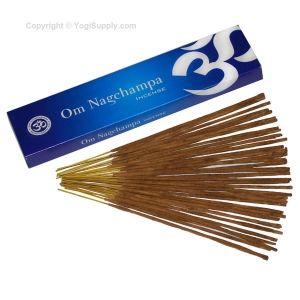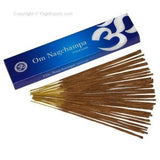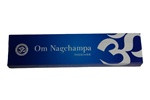Om Nag Champa - 40 gms
Om Nag Champa, 40 gram box. 8 inch sticks. "Masala" incense, a complex blend of natural aromatic ingredients mixed into a dough and hand rolled onto a stick. Each stick burns for approximately one hour. NEW! Nag Champa belongs to the "Champa" class of Indian incense, originating from the Champa flower. Champa incenses contain a natural ingredient indigenous to India called "halmaddi", which is a semi-liquid resin taken from the Ailanthus Malabarica tree. It is what gives Nag Champa its characteristic grey color. Halmaddi is hygroscopic which means it absorbs moisture from the air. Nag Champa belongs to the "Champa" class of Indian incense, originating from the Champa flower. Champa incenses contain a natural ingredient indigenous to India called "halmaddi", which is a semi-liquid resin taken from the Ailanthus Malabarica tree. It is what gives Nag Champa its characteristic grey color. Halmaddi is hygroscopic which means it absorbs moisture from the air. Nag Champa is based on sandalwood (chandan), with a secret recipe of many more herbal scents added in. For this reason, chandan/sandalwood is an important part of this assortment to say the least, since there are three varieties that involve it in their recipes. Why is sandalwood an ingredient in so many different kinds of incense? Chandan, also known as Sandalwood, is considered to be of the padma (lotus) group, associated with the qualities of Amitabha Buddha, which are compassion, devotion, and love. Chandan's scent is believed to purify desires and maintain a person's alertness while in meditation. Chandan is also one of the more popular scents used when offering incense. Sandalwood smells somewhat like other wood scents, except it has a bright and fresh edge with few natural analogues. Its sedative property clears stress from the nervous system. Called Chandana, Rakta or Raktachandana, Red Sandalwood is a traditional Indian incense and dye wood used for ritual, meditation, candlemaking and cloth dyeing. In Hindu marriages, it is burned on a sacred fire within the marriage tent so that the fumes surround the bridal pair. The sandal tree, botanically known as Santalum Album, belongs to the family Santalaceae. The sandal tree grows almost exclusively in the forests of Karnataka, followed by Tamil Nadu, Kerala, Andhra Pradesh, and the Timor Islands of Indonesia. Because of chandan's (sandalwood's) enrichment of the Padma (Lotus) Buddha wisdom qualities, it is the most frequently used scent for Bhakti (devotion) practices, since sandalwood or chandan is a tonic to the heart, evocative of calm love and devotion. According to traditional Ayurvedic sources, Chandan dispels nervousness, cooling, clears depression, relaxes headache, lessens insomnia, reduces stomach pains, helps urinary troubles, relieves Pitta heat conditions, sunburn, acne, rashes, fevers, herpes, sores, ulcers, pitta imbalance, and heat sickness. It is also calming, helps sleep, and centers the mind.



